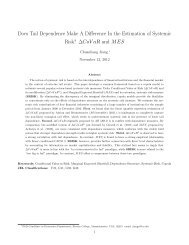HISTORY OF MATH HOMEWORK 5 SOLUTIONS 9.30, 32, 35, 37 ...
HISTORY OF MATH HOMEWORK 5 SOLUTIONS 9.30, 32, 35, 37 ...
HISTORY OF MATH HOMEWORK 5 SOLUTIONS 9.30, 32, 35, 37 ...
You also want an ePaper? Increase the reach of your titles
YUMPU automatically turns print PDFs into web optimized ePapers that Google loves.
<strong>HISTORY</strong> <strong>OF</strong> <strong>MATH</strong><br />
<strong>HOMEWORK</strong> 5 <strong>SOLUTIONS</strong><br />
<strong>9.30</strong>, <strong>32</strong>, <strong>35</strong>, <strong>37</strong>, 38<br />
<strong>9.30</strong>. Use Cardano’s formula to solve x 3 = 6x + 6.<br />
We have p = −2, q = 3, so q 2 + p 3 = 1. The positive real solution is<br />
x = [3 + 1] 1/3 + [3 − 1] 1/3 = 4 1/3 + 2 1/3 .<br />
The general solution is<br />
w + 2 w ,<br />
where w is any cube root of 4.<br />
9.<strong>32</strong>. Solve x 3 + 21x = 9x 2 + 5.<br />
Making the substitution x = y + 3 leads to the equation<br />
y 3 − 6y + 4 = 0.<br />
Trying divisors of 4, we find that y = 2 is a root, and that<br />
y 3 − 6y + 4 = (y − 2)(y 2 + 2y − 2).<br />
The latter quadratic has roots −1 ± √ 3, so the original equation has roots<br />
x = 5, 2 ± √ 3.<br />
We don’t need Cardano for this, since there was a rational root. In fact, Cardano gives<br />
x = [−2 + 2 √ −1] 1/3 + [−2 − 2 √ −1] 1/3 .<br />
The Bombelli procedure gives the cube root 1 ± √ −1 of −2 ± 2 √ −1, and indeed (1 + √ −1) +<br />
(1 − √ −1) = 2.<br />
1
2 <strong>HISTORY</strong> <strong>OF</strong> <strong>MATH</strong> <strong>HOMEWORK</strong> 5 <strong>SOLUTIONS</strong><br />
9.<strong>35</strong> Solve the system of equations<br />
x 3 + 3xy 2 = x + y + 64<br />
y 3 + 3yx 2 = x + y<br />
Subtract the two equations and get (x − y) 3 = 64, so x − y = 4. Substitute y = x − 4 into the<br />
second equation and get<br />
y 3 + 6y 2 + 23<br />
2 y − 1 = 0.<br />
Let y = z − 2, to get<br />
z 3 − 1z = 8. 2<br />
So p = −1/6 and q = 4 and q 2 + p 3 = 16 − 1/216 = 3455/216. Cardano’s (actually Tartaglia’s<br />
in this case!) formula gives<br />
y = z − 2 = −2 +<br />
and x = y + 4 as shown above.<br />
[<br />
4 +<br />
√ ] 1/3 [<br />
3455<br />
+ 4 −<br />
216<br />
√ ] 1/3<br />
3455<br />
,<br />
216<br />
9.<strong>37</strong> The equation x 3 + 3x = 36 has the root r = 3, but Cardano’s formula gives<br />
Explain this using Bombelli’s methods.<br />
r = [18 + √ <strong>32</strong>5] 1/3 + [18 − √ <strong>32</strong>5] 1/3 .<br />
The numbers<br />
α = [18 + √ <strong>32</strong>5] 1/3 , β = [18 − √ <strong>32</strong>5] 1/3<br />
Satisfy<br />
α + β = r, αβ = −p,<br />
so they are the roots of the quadratic Y 2 − rY − p = 0, where r = 3 and p = 1. The quadratic<br />
formula then gives<br />
α, β = 1[3 ± √ 13].<br />
2<br />
You can check that<br />
( 1 [3 + √ 13] ) 3 √<br />
2 = 18 + <strong>32</strong>5,<br />
( 1 [3 − √ 13] ) 3 √<br />
2 = 18 − <strong>32</strong>5,<br />
so<br />
α = 1 2 [3 + √ 13], β = 1 2 [3 − √ 13].
<strong>HISTORY</strong> <strong>OF</strong> <strong>MATH</strong> <strong>HOMEWORK</strong> 5 <strong>SOLUTIONS</strong> 3<br />
9.38 Express [52 + √ −2209] 1/3 in the form a + b √ −1.<br />
Note that 2209 = 47 2 . So we must find a, b such that<br />
Working out the cube gives two equations<br />
(a + b √ −1) 3 = 52 + 47 √ −1.<br />
a 3 − 3ab 2 = 52, 3a 2 b − b 3 = 47.<br />
Adding these gives<br />
(a − b)(a 2 + 4ab + b 2 ) = 99.<br />
Subtracting gives<br />
(a + b)(a 2 − 4ab + b 2 ) = 5.<br />
Now let’s be optimistic and look for integer solutions for a, b. The latter equation says that a + b<br />
divides 5, so a + b = ±1, ±5. We find that a + b = 5 leads to<br />
a 2 − 4a(5 − a) + (5 − a) 2 = 1,<br />
which has solutions a = 1, 4, hence b = 4, 1. But the first equation says that a − b > 0, so we<br />
take a = 4, b = 1, and note that this satisfies both equations. Hence<br />
[52 + √ −2209] 1/3 = 4 + √ −1.<br />
Another way to do this, without guessing, is to reconstruct the cubic for which [52+ √ −2209] 1/3<br />
arises in the Cardano formula. We have q = 52 and p 3 = −2209 − q 2 = −17 3 so p = −17. The<br />
cubic<br />
x 3 − 51x = 104<br />
has the root r = 8. So<br />
8 = [52 + √ −2209] 1/3 + [52 − √ −2209] 1/3 .<br />
The quadratic<br />
Y 2 − rY − p = Y 2 − 8Y + 17<br />
has roots 4 ± √ −1. Cubing these, we find that (4 + √ −1) 3 = 52 + √ −2209.

















